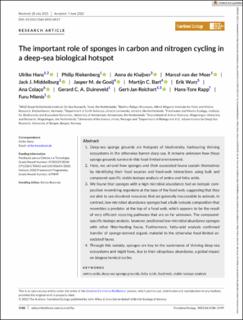| dc.contributor.author | Hanz, Ulrike | |
| dc.contributor.author | Riekenberg, Philip | |
| dc.contributor.author | de Kluijver, Anna | |
| dc.contributor.author | van der Meer, Marcel | |
| dc.contributor.author | Middelburg, Jack J. | |
| dc.contributor.author | de Goeij, Jasper M. | |
| dc.contributor.author | Bart, Martijn C. | |
| dc.contributor.author | Wurz, Erik | |
| dc.contributor.author | Colaço, Ana | |
| dc.contributor.author | Duineveld, Gerard C. A. | |
| dc.contributor.author | Reichart, Gert-Jan | |
| dc.contributor.author | Rapp, Hans Tore | |
| dc.contributor.author | Mienis, Furu | |
| dc.date.accessioned | 2023-02-28T14:52:23Z | |
| dc.date.available | 2023-02-28T14:52:23Z | |
| dc.date.created | 2022-09-27T08:29:51Z | |
| dc.date.issued | 2022 | |
| dc.identifier.issn | 0269-8463 | |
| dc.identifier.uri | https://hdl.handle.net/11250/3054755 | |
| dc.description.abstract | Deep-sea sponge grounds are hotspots of biodiversity, harbouring thriving ecosystems in the otherwise barren deep sea. It remains unknown how these sponge grounds survive in this food-limited environment.
Here, we unravel how sponges and their associated fauna sustain themselves by identifying their food sources and food-web interactions using bulk and compound-specific stable isotope analysis of amino and fatty acids.
We found that sponges with a high microbial abundance had an isotopic composition resembling organisms at the base of the food web, suggesting that they are able to use dissolved resources that are generally inaccessible to animals. In contrast, low microbial abundance sponges had a bulk isotopic composition that resembles a predator at the top of a food web, which appears to be the result of very efficient recycling pathways that are so far unknown. The compound-specific-isotope analysis, however, positioned low-microbial abundance sponges with other filter-feeding fauna. Furthermore, fatty-acid analysis confirmed transfer of sponge-derived organic material to the otherwise food-limited associated fauna.
Through this subsidy, sponges are key to the sustenance of thriving deep-sea ecosystems and might have, due to their ubiquitous abundance, a global impact on biogeochemical cycles. | en_US |
| dc.language.iso | eng | en_US |
| dc.publisher | Wiley | en_US |
| dc.rights | Navngivelse 4.0 Internasjonal | * |
| dc.rights.uri | http://creativecommons.org/licenses/by/4.0/deed.no | * |
| dc.title | The important role of sponges in carbon and nitrogen cycling in a deep-sea biological hotspot | en_US |
| dc.type | Journal article | en_US |
| dc.type | Peer reviewed | en_US |
| dc.description.version | publishedVersion | en_US |
| dc.rights.holder | Copyright 2022 The Author(s) | en_US |
| cristin.ispublished | true | |
| cristin.fulltext | original | |
| cristin.qualitycode | 2 | |
| dc.identifier.doi | 10.1111/1365-2435.14117 | |
| dc.identifier.cristin | 2055705 | |
| dc.source.journal | Functional Ecology | en_US |
| dc.source.pagenumber | 2188-2199 | en_US |
| dc.identifier.citation | Functional Ecology. 2022, 36 (9), 2188-2199. | en_US |
| dc.source.volume | 36 | en_US |
| dc.source.issue | 9 | en_US |

